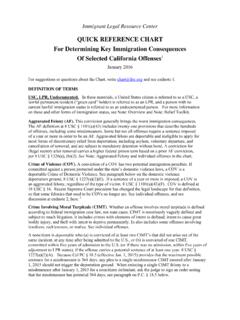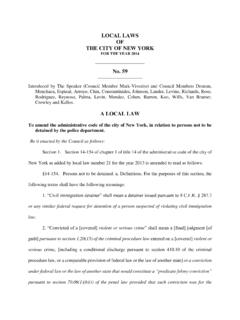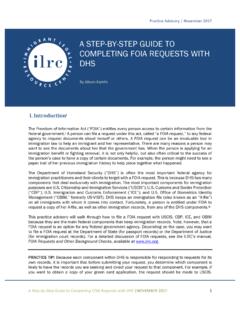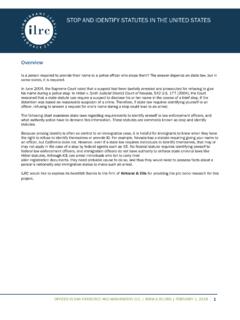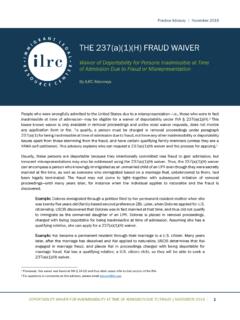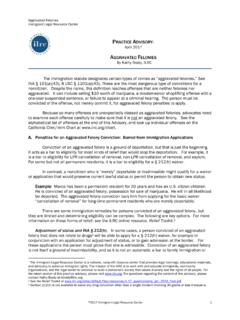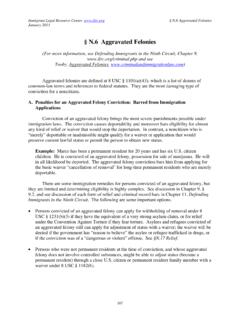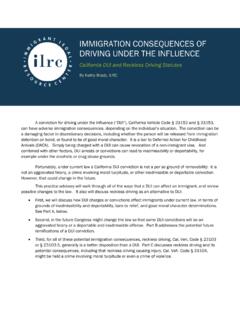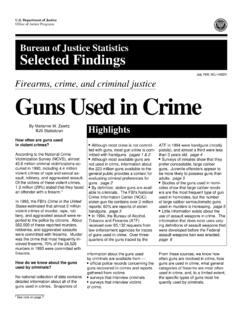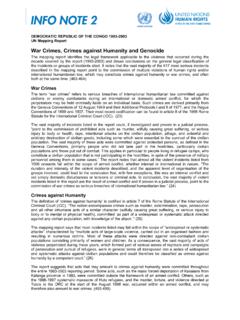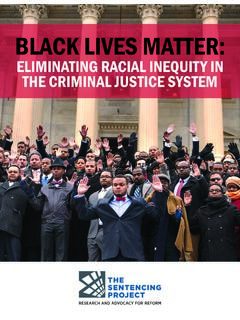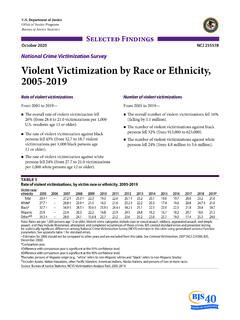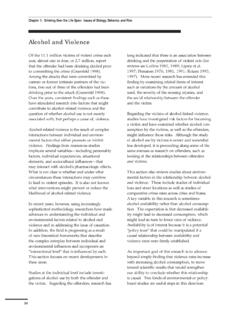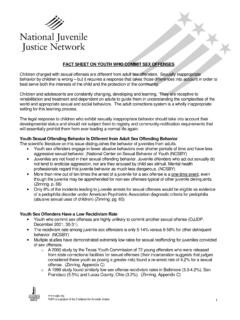Transcription of § N.7 Crimes Involving Moral Turpitude - ILRC
1 Immigrant Legal Resource Center, Crimes Involving Moral Turpitude January 2013 Crimes Involving Moral Turpitude (For more information, see Defending Immigrants in the Ninth Circuit, Chapter 4, including Appendix 4-A, Annotations and Chart of Crimes Involving Moral Turpitude under California Law) Overview Box A. Is the Offense a crime Involving Moral Turpitude ( CIMT )? B. Does the Conviction make the Defendant Deportable under the CIMT Ground? C. Does the Conviction make the Defendant Inadmissible under the CIMT Ground? Appendix 7-I Legal Summaries to Give to the Defendant Appendix 7-II Cheat Sheet: Rules for When a CIMT is an Inadmissible or Deportable Offense Overview: Crimes Involving Moral Turpitude . Because many offenses come within the immigration category of Crimes Involving Moral Turpitude ( CIMT ), criminal defense counsel must always keep this category in mind.
2 There are two steps to analyzing CIMTs. First, determine whether an offense is or might be a CIMT. Generally this requires intent to cause great bodily harm, defraud, or permanently deprive an owner of property, or in some cases to act with lewd intent or recklessness. See Part A below. Second, if the offense is or may be a CIMT, see if according to the immigration statute formulae for CIMTs based on number of convictions, when committed, sentence - the conviction would actually make this defendant inadmissible and/or deportable under the CIMT grounds. In some cases a single CIMT conviction will not make a noncitizen inadmissible and/or deportable. See Parts B and C below for these rules. An administrative decision, Matter of Silva-Trevino, has made it impossible to tell whether certain offenses will be held CIMT s.
3 Often the best course is to conservatively assume that a borderline offense is a CIMT, do the analysis to see if it will make the noncitizen defendant deportable and/or inadmissible, and warn the defendant accordingly. A waiver or some other defense strategy might be available. Hopefully the Ninth Circuit will overturn Silva-Trevino. As always, remember that a single conviction might come within multiple immigration categories. For example, a CIMT offense might or might not also be an aggravated felony. Look up the section in the California Quick Reference Chart to check all categories. 111 Immigrant Legal Resource Center, Crimes Involving Moral Turpitude January 2013 A. Is the Offense a crime Involving Moral Turpitude ? (including Matter of Silva-Trevino) A crime Involving Moral Turpitude ( CIMT ) has been vaguely defined as a depraved or immoral act, or a violation of the basic duties owed to fellow man, or recently as a reprehensible act with a mens rea of at least recklessness.
4 Matter of Silva-Trevino, 24 I&N Dec. 687 (AG 2008). Traditionally a CIMT involves intent to commit fraud, commit theft with intent to permanently deprive the owner, or inflict great bodily harm, as well as some reckless or malicious offenses and some offenses with lewd intent. For criminal defenders, the first step to see if an offense is a CIMT is to consult the California Quick Reference Chart. However, because this area of the law is in flux, you also must be aware of the points in this Note. Note also that whether a particular offense constitutes a CIMT for immigration purposes is determined by federal immigration caselaw, not state rulings for purposes of witness impeachment or license limitations. How Matter of Silva-Trevino makes it harder to guarantee a conviction will not be a CIMT.
5 To make a long story short,1 currently it can be hard to determine if a conviction will be held to be a CIMT because of the administrative case, Matter of Silva-Trevino, 24 I&N Dec. 687 ( 2008). Under Silva-Trevino, in some cases an immigration judge will be able to go beyond the record of conviction and hold a hearing on the facts about the defendant s conduct, to see if the defendant committed a crime Involving Moral Turpitude . The judge can take testimony from the defendant, review police reports, etc., and may even consider facts not required to prove an element of the offense. Therefore, while counsel should strive to protect the defendant from a CIMT conviction by choosing the right plea or controlling the record of conviction, as long as Silva-Trevino remains in effect, the defendant might end up with a CIMT conviction.
6 How to protect a client despite Silva-Trevino. There are two defense strategies that will protect a client from a CIMT conviction despite Silva-Trevino. If you succeed in negotiating a disposition according to these strategies, give the client a copy of the legal summary that appears at Appendix I following this Note. 1. With a divisible statute, plead specifically to conduct that is not a CIMT A divisible statute reaches conduct that is and is not a CIMT. It is clear that if the record of conviction specifically identifies elements that do not involve CIMT, the immigration judge may not go beyond that and may not conduct a fact-based inquiry under Thus for CIMT purposes, instead of creating a vague record of conviction, where possible one should plead to a specific offense that does not involve Moral Turpitude .
7 Example: Calif. Veh. Code 10851 is divisible as a CIMT, because it covers both auto theft with intent to permanently deprive the owner of property (a CIMT), and joyriding 1 For further discussion of Silva-Trevino see Brady et al, Defending Immigrants in the Ninth Circuit (2011, ) or see Tooby, Kesselbrenner, Living with Silva-Trevino at 2 Matter of Alfaro, 25 I&N Dec. 417 (BIA 2011); Matter of Silva-Trevino, 24 I&N Dec. 687, 699 (AG 2008). 112 Immigrant Legal Resource Center, Crimes Involving Moral Turpitude January 2013 with temporary intent (not a CIMT). If the defendant specifically pleads to taking with temporary intent, then the conviction is not a CIMT. But if the record is vague between temporary and permanent taking, the immigration judge may conduct to determine the intent.
8 She might take testimony from the immigrant, examine the probation report, etc. Another commonly charged divisible statute is 243(e). The offense is a CIMT if it involved use of actual violent force, but not if it involved offensive touching or other de minimus force. A specific plea to the latter prevents the offense from being a CIMT, even under Silva-Trevino. 2. Plead to an offense that requires intent of negligence or less An offense Involving negligence or less is not a CIMT. For example, it has long been held that simple drunk driving, even with injury or as a repeat offense, is not a See other offenses in the Chart that also should not be held to involve Moral Turpitude under any circumstances. Caveat: Because there are reports that some immigration judges may blur this rule under Silva-Trevino, a conviction for drunk driving coupled with a conviction for driving on a suspended license in the same incident might be held to be a CIMT, if the immigration judge were to (wrongly) combine the two offenses.
9 The adverse Silva-Trevino rule only applies to CIMT determinations. If the immigration court does conduct a broad factual inquiry under Silva-Trevino, it may use the information only to determine if the offense involves Moral Turpitude , and not to determine if the conviction comes within other grounds of inadmissibility or deportability. 4 Example: Mike pleads guilty to 243(e), spousal battery. If this offense is committed with offensive touching, it is neither a CIMT nor a deportable crime of domestic violence. If instead it is committed with actual violence, it will be held a CIMT and a deportable crime of domestic Mike s defender creates a vague record of conviction in which Mike pleads to the language of the statute, which does not establish whether the offense involved actual violence or an offensive touching.
10 Under Silva-Trevino, for CIMT inquiries only, an immigration judge may make a factual inquiry into Mike s conduct. Based on this inquiry she might find that real violence was involved and the offense is a CIMT. The judge may not use this information to hold that the offense is a deportable crime of domestic violence. Here the regular evidentiary rules known as the categorical approach apply, and the judge must base her decision only upon the reviewable record of conviction. Since the vague record does not establish that the offense involved actual 3 Matter of Torres-Varela, 23 I&N Dec. 78 (BIA 2001). 4 This opinion does not, of course, extend beyond the Moral Turpitude issue--an issue that justifies a departure from the Taylor/Shepard framework because Moral Turpitude is a non-element aggravating factor that stands apart from the elements of the [underlying criminal] offense.
